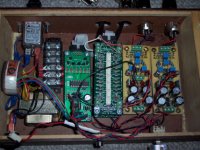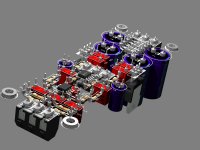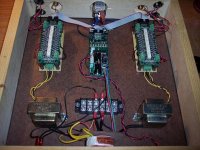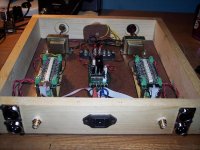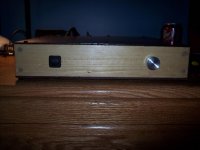Hello All, I am not sure where this blenongs. It is a design based on a chip, but it is also in no small part brought to us by our friend Nelson Pass, so i have posted it here. If this is not correct, moderators feel free to move it.
Twisted Sibling.
Hello Friends,
It was not long ago I read that Texas Instruments had licensed from Nelson Pass the rights to produce products based on his Super Symmetry intellectual property.
Well I was very pleased about that as it meant the very likely we (the DIY community) now have a very widely available fabulous basis for many incredible projects to come. We would at last have a fully symmetric device on which to build many interesting applications. Well as it turns out several devices to choose from.
One such device is the THS413X. Which has some amazing specs. I will not regurgitate the data sheet for you here, instead I will tell you what I decided to do with what turns out to be a fantastic chip.
Basically I made a circuit that behaves very much like our (actually Terry Aben's) Twisted XBOSOZ, but in a very much smaller much more convenient package(1.5” x 4”). This project has been about two months in the making as has now been tested and found to be even more than I had ever hoped it would be.
The designed circuit is a mono amplifier/buffer which can be used with single ended or balanced input and single ended or balanced output. It can be used to directly feed something like a Super Symmetrical chipamp such as the one Terry Aben was so kind to share with us and I am now listening to. The circuit can also simply be used as an excellent compact SE to balanced converter.
The circuit has exceptional PSRR and CMRR which is phenomenal. Distortion figures and simulates very low indeed (<-110 db 3rd order in the audio range). I have not been able to actually test my circuit yet, but my ears tell me that the data sheet has not disappointed. the circuit will easily outperform the best current feedback conventiuonal opamps such as the AD815 and be much easier to live with to boot. No nasty offset to deal with by using a servo or by injecting current from the supply rail.
But I do not have to talk about numbers or pie in the sky claims. The circuit is very easy to build!!! I will share my research freely here in the true spirit of DIY audio, I am not divulging trade secrets or anything one could not easily glean from various online sources. The only thing I expect in return is that people enjoy the project. Sure I worked hard on this, not I did not invent anything.
I will share my research freely here in the true spirit of DIY audio, I am not divulging trade secrets or anything one could not easily glean from various online sources. The only thing I expect in return is that people enjoy the project. Sure I worked hard on this, not I did not invent anything.
The Circuit has some incredibly useful features. Look it over for yourself.
Here are some highlights:
1)High input impedance with optional low pass filter which makes it an ideal line stage to follow a Sigma Delta (or any voltage output) DAC such as the one I am working on now.
2)Extremely low output impedance.
3)High output current capability (up to 150ma).
4)Very low voltage noise.
5)High slew rate.
6)High bandwidth.
7)Very low harmonic distortion.
8)SE to balanced conversion is simple(Tie -In to GND).
This would be a great font end to many bridged or bridged/parallel amps.
Here is the completed prototype which is driving a SuSy chipamp. It is setup for 2X gain. The front end is a AD8620 which is configured as a instrumentation amp along with the THS4131. You could use any unity gain stable dual op amp which is good for audio on the front end.
I could go on and on about the results, but you would never believe me. Please build one for yourself. I think you like me may just be speechless.
I will post single sided PCB PDFs which are free for DIY use.
I will post the schematic.
I look forward to lots of feedback.
Lets start with the schematic:
Twisted Sibling.
Hello Friends,
It was not long ago I read that Texas Instruments had licensed from Nelson Pass the rights to produce products based on his Super Symmetry intellectual property.
Well I was very pleased about that as it meant the very likely we (the DIY community) now have a very widely available fabulous basis for many incredible projects to come. We would at last have a fully symmetric device on which to build many interesting applications. Well as it turns out several devices to choose from.
One such device is the THS413X. Which has some amazing specs. I will not regurgitate the data sheet for you here, instead I will tell you what I decided to do with what turns out to be a fantastic chip.
Basically I made a circuit that behaves very much like our (actually Terry Aben's) Twisted XBOSOZ, but in a very much smaller much more convenient package(1.5” x 4”). This project has been about two months in the making as has now been tested and found to be even more than I had ever hoped it would be.
The designed circuit is a mono amplifier/buffer which can be used with single ended or balanced input and single ended or balanced output. It can be used to directly feed something like a Super Symmetrical chipamp such as the one Terry Aben was so kind to share with us and I am now listening to. The circuit can also simply be used as an excellent compact SE to balanced converter.
The circuit has exceptional PSRR and CMRR which is phenomenal. Distortion figures and simulates very low indeed (<-110 db 3rd order in the audio range). I have not been able to actually test my circuit yet, but my ears tell me that the data sheet has not disappointed. the circuit will easily outperform the best current feedback conventiuonal opamps such as the AD815 and be much easier to live with to boot. No nasty offset to deal with by using a servo or by injecting current from the supply rail.
But I do not have to talk about numbers or pie in the sky claims. The circuit is very easy to build!!!
The Circuit has some incredibly useful features. Look it over for yourself.
Here are some highlights:
1)High input impedance with optional low pass filter which makes it an ideal line stage to follow a Sigma Delta (or any voltage output) DAC such as the one I am working on now.
2)Extremely low output impedance.
3)High output current capability (up to 150ma).
4)Very low voltage noise.
5)High slew rate.
6)High bandwidth.
7)Very low harmonic distortion.
8)SE to balanced conversion is simple(Tie -In to GND).
This would be a great font end to many bridged or bridged/parallel amps.
Here is the completed prototype which is driving a SuSy chipamp. It is setup for 2X gain. The front end is a AD8620 which is configured as a instrumentation amp along with the THS4131. You could use any unity gain stable dual op amp which is good for audio on the front end.
I could go on and on about the results, but you would never believe me. Please build one for yourself. I think you like me may just be speechless.
I will post single sided PCB PDFs which are free for DIY use.
I will post the schematic.
I look forward to lots of feedback.
Lets start with the schematic:
Attachments
Ed Lafontaine said:By the way, which of the many available packages..er..ah..Which suffix (at the end of 4131) did you use to put this together?
Ha,
This time of year cutting grass is unavoidable.
I used THS4131CD in my prototype. They are SOIC. I have been using a hot plate and solder paste to solder my SMD parts lately. Wow, does it make it easy.
Cheers!
Russ
Banned
Joined 2002
Russ White said:BTW sorry for all the gramatical and spelling errors. I should have proof read my pssstss .



Is this a buffer for balanced Signals ?
jleaman said:
Is this a buffer for balanced Signals ?
Jason, functionally, it works like XBOSOZ.
To make it a buffer R2A and R2B would be very low value or a jumper. Rg and Rf would be 390R.
Cheers!
Russ
00940 said:the opa1632 is apparently the same chip and cost way cheaper than the ths4131.
Similar, yes very much so, the same no.
The question was raised here : http://www.diyaudio.com/forums/showthread.php?threadid=35775Russ White said:
Similar, yes very much so, the same no.
You got more info from other sources ? The specs are so amazingly similar...
I will call TI today to find out, but I can see some differences in the data sheet (though not many and not by much) but the big thing is that the THS413x data sheet specifically states this:
Where as the OPA1632 does not.
Does that mean anything? Well who knows. But in the end both chips are cheap and you can use either one. So am not sure how it makes any difference.
I will call TI today and ask, just to satisfy my curiosity.
:EDIT: missed most of the quote.
Cheers!
Russ
The THS413x is one in a family of fully-differential input/differential output devices fabricated using Texas Instruments' state-of-the-art BiComI complementary bipolar process.
Where as the OPA1632 does not.
Does that mean anything? Well who knows. But in the end both chips are cheap and you can use either one. So am not sure how it makes any difference.
I will call TI today and ask, just to satisfy my curiosity.
:EDIT: missed most of the quote.
Cheers!
Russ
patriz said:I would be glad if you post the pcb pdf.
Thank you
Giorgio
Your wish is granted.
The copper PDF is not mirrored (for toner transfer).
The silk PDF is mirrored (also for toner transfer).
Enjoy!
PDFs
Cheers!
Russ
- Status
- This old topic is closed. If you want to reopen this topic, contact a moderator using the "Report Post" button.
- Home
- Amplifiers
- Pass Labs
- Twisted Sibling - THS4131 based preamp/buffer/SE-BAL converter
